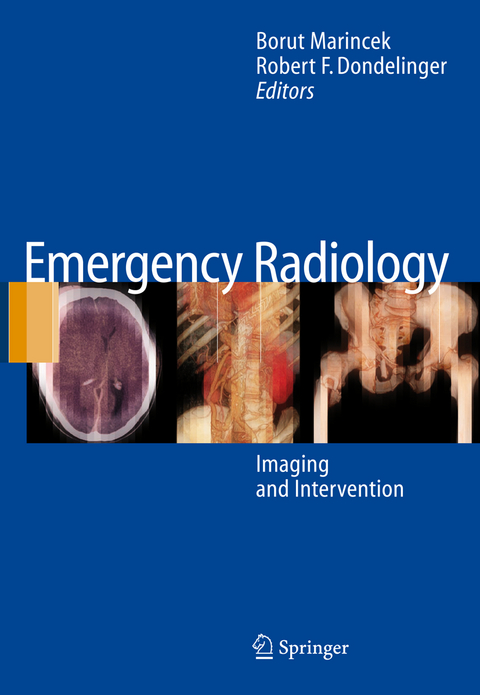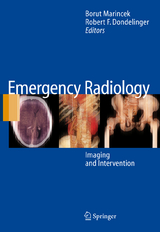Emergency Radiology
Springer Berlin (Verlag)
978-3-540-26227-5 (ISBN)
Why write a book on emergency radiology? In many coun- decline. There is an increasing trend towards the use of tries, hospital emergency departments have become a MDCT to evaluate traumatic injuries and non-traumatic major part of the healthcare safety net. In the last decade emergencies. The use of workstations for reporting and for economically-driven structural changes in health care further image reconstruction becomes standard practice. delivery have caused a dramatic increase in emergency On the occasion of the European Congress of Radiology department visits. In response to capacity and staffing (ECR) 2003 and 2004 a Categorical Course on "Emergency pressures, hospitals are developing and implementing a Radiology"has been organized to assess current devel- variety of strategies designed to improve patient flow and ments and concepts in this rapidly growing field. reduce overcrowding in the emergency department. Numerous radiologists,all outstanding and international- Several factors are considered critical for success, such as ly renowned experts in their field,have made superb c- having the right multidisciplinary teams in place and opti- tributions in an ECR syllabus. These authors have now mizing the use of imaging tests. For a critical care physi- made a second effort and updated their contributions for cian it is paramount to obtain the images quickly and for this book. The chapters in the book mirror the topics p- them to be interpreted accurately. sented in the ECR course, encompassing imaging ap- To accomplish this, the emergency radiology division proaches as well as interventional aspects.
Emergency Radiology: Role of Imaging.- Role of Imaging in the Management of Trauma Victims.- Role of 3D Imaging in the Emergency Room.- Traumatic Injuries: Imaging and Intervention.- Hemostatic Arterial Embolization in Trauma Victims at Admission.- Imaging and Intervention in Post-traumatic Complications (Delayed Intervention).- Imaging of Head Injuries.- Imaging of Facial Injuries.- Imaging of Spinal Injuries.- Imaging of Thoracic Injuries.- Vascular Injuries of the Thorax: Multi-Detector-Row CT and 3D Imaging.- Imaging of Abdominal and Pelvic Injuries.- Imaging and Intervention of Large Arterial Trauma.- Pelvic Fractures.- Traumatic Injuries: Imaging of Peripheral Muskuloskeletal Injuries.- Non-Traumatic Neurologic Emergencies: Imaging and Intervention.- Imaging of Cerebral Ischemia.- Neuroradiological Emergency Interventions.- Non-Traumatic Thoracic Emergencies: Imaging and Intervention.- Acute Chest Pain: Diagnostic Strategies.- CT Diagnosis of Acute Pulmonary Embolism.- CT Venography in an Integrated Diagnostic Strategy of Acute Pulmonary Embolism and Venous Thrombosis.- Imaging and Treatment of Thoracic Fluid and Gas Collections.- Non-Traumatic Abdominal Emergencies: Imaging and Intervention.- Acute Abdominal Pain: Diagnostic Strategies.- Imaging of Acute Intestinal Obstruction.- Imaging and Intervention in Gastrointestinal Hemorrhage and Ischemia.- Imaging and Intervention in Sepsis.- Non-traumatic Abdominal Emergencies: Imaging and Intervention in Acute Biliary Conditions.- Imaging and Intervention in Acute Pancreatic Conditions.- Non-traumatic Uroradiological Emergencies.- Non-Traumatic Vascular Emergencies: Imaging and Intervention.- Imaging and Intervention in Acute Non-traumatic Arterial Condition.- Imaging and Intervention in Acute Venous Occlusion.- Management of Occluded Hemodialysis Shunts, Grafts, and Venous Access.- Imaging Pediatric Emergencies.- Pediatric Neurological Emergencies.- Thoracic Emergencies.- Pediatric Emergencies: Non-traumatic Abdominal Emergencies.
From the reviews:
" ... This book successfully meets its goal of providing an up-to-date reference that addresses emergency imaging and interventions. It is a useful companion to similar previously published texts in emergency radiology but adds the useful facet of including interventional approaches to a spectrum of emergent conditions ... This book would be well positioned as a ready reference in both academic and private practice reading rooms and would benefit emergency medicine physicians as well. "
David D. Pellei, MD; Radiology: Volume 247: Number 1 - April 2008)
"A new text has emerged that deals with the extensive field of emergency radiology. ... the book is informative, up to date, and enjoyable. ... The subject matter is well presented and would be useful to emergency department physicians and radiology residents rotating through a trauma center or emergency radiology department. Those radiologists whose practice does not include the performance of interventional procedures would also benefit from the information in this volume." (American Journal of Neuroradiology, Vol. 29, March, 2008)
| Erscheint lt. Verlag | 20.11.2006 |
|---|---|
| Zusatzinfo | XVIII, 650 p. 1000 illus., 400 illus. in color. |
| Verlagsort | Berlin |
| Sprache | englisch |
| Maße | 193 x 270 mm |
| Gewicht | 1955 g |
| Themenwelt | Medizinische Fachgebiete ► Radiologie / Bildgebende Verfahren ► Radiologie |
| Schlagworte | Abdominal Emergency • Computed tomography (CT) • Diagnosis • diagnostic radiology • Emergency Medicine • Gastrointestinal Emergency • Musculoskeletal Emergency • Non-Traumatic Emergencies • Notfallmedizin • Notfallmedizin / Akutmedizin • Pediatric Emergency • Polytrauma • Radiologie • Radiology • Thoracic Emergency • Trauma • trauma surgery • Traumatic Injuries • VAS • Vascular Emergency |
| ISBN-10 | 3-540-26227-X / 354026227X |
| ISBN-13 | 978-3-540-26227-5 / 9783540262275 |
| Zustand | Neuware |
| Informationen gemäß Produktsicherheitsverordnung (GPSR) | |
| Haben Sie eine Frage zum Produkt? |
aus dem Bereich




